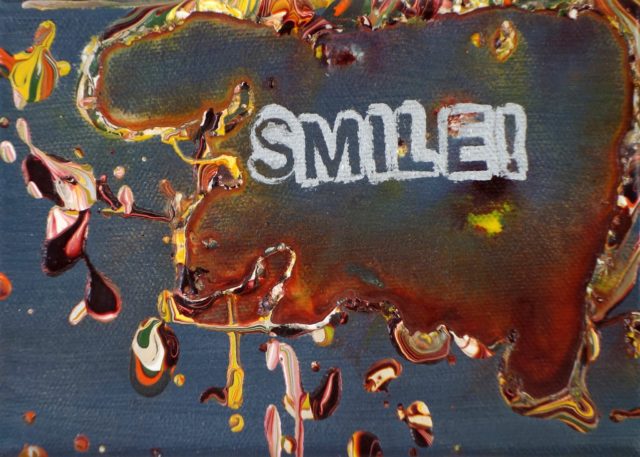
Betty Tompkins, “Smile!” 2016, acrylic on canvas
Is recent art history repeating itself? An increasingly long roster of new all-women group exhibitions and their corresponding press seem to suggest so. From blue-chip stalwarts Hauser Wirth & Schimmel and Saatchi to smaller project and artist-run spaces to last night’s Marc Straus opening If Only Bella Abzug Were Here, are all-female group shows an indication of a permanent commitment to gender equality in the art world or is it just another doomed-to-disappear trend?
This noticeable influx of women-only exhibitions seems to harken back to the “girl power” days of the 1990’s as exemplified by the New Museum’s 1994 show Bad Girls. In contrast to today’s female-centric shows, however, Bad Girls also featured male artists–a decision New Museum founder Marcia Tucker addressed in the catalogue:
“Besides wanting to transgress the usual premise for an exhibition about feminist issues–that it contains only the work of women–we’re not interested in reinforcing a separate category of ‘women’s art,’ nor do we insist on women’s concerts being inherently different from those of men, no matter how fed up with some of the latter we might be.”
Tucker’s explanation highlights the nagging questions surrounding this current glut of all-women exhibitions. With a still-considerable imbalance in gender equality, do all-women shows help correct this pervasive disparity or do they reinforce women’s status as an outsider? Do all-women shows risk restricting the long-term understanding of a woman artist’s work to solely her gender?
“I think that anyone who has a problem with all-female shows is a misogynist,” declares Untitled Space’s Indira Cesarine. Founding Untitled Space partially “to emphasize contemporary female artists and feminist art as a genre,” Cesarine and her co-curator Coco Dalle’s current exhibition In the Raw: The Female Gaze on the Nude explores the historically underappreciated female representation of women’s bodies.
Even though she hopes “perhaps after a few decades of impact the need for ‘all-female’ shows might lessen and we will see more diversity and inclusion,” Cesarine refuses to see the surge in all-women shows as a trend:
“The fact that there are a handful of ‘all-female’ shows is nothing compared to thousands of years of male domination in the art world. Female artists were not even acknowledged 100 years ago, and we have a long way to go before there is any real balance….I think we are seeing the beginning, and hopefully no, it’s not a trend. All female shows create an impact and attempt to shift a heavily weighted imbalance…”
For Cesarine, all-women shows provide a corrective to the long lineage of women’s invisibility by, as she says, giving the female voice “a chance to stand on its own and be presented in a contemporary context.”
Similarly, independent curator Jenny Mushkin Goldman understands “the need for giving people who have been disenfranchised more of a leg-up.” Mushkin Goldman organized her current all-women exhibition Smile! at Shin Gallery’s Koreatown project space in response to an eye-roll-inducing tweet by MSNBC pundit Joe Scarborough who suggested presidential candidate Hillary Clinton “smile” after a night of March primary wins.
Using this tweet as a catalyst to discuss catcalling and the objectification of women through artists like Betty Tompkins, Deborah Kass and Rebecca Goyette, Mushkin Goldman’s Smile! reflects her view that the impact of all-women shows depends on the strength and complexity of its curatorial vision. She observes:
“I think it’s important to give a platform for women in general but I think that specifically this is an issue that affects almost only women, which is why it is an all-women show. Do I think I need to have shows and just make it an all-women show for no particular reason? Not really. I would prefer to not first seek out a gender and then seek out the art. It should be the opposite.”
Despite the art world’s reticence to see itself as part of popular culture, these all-women shows come at a time when the visibility of feminism appears to be at an all-time high with Beyoncé, Lena Dunham and even, the all-female Ghostbusters reboot. In the 1990s, Bad Girls didn’t just come from nowhere either with the Lilith Fair, Riot grrrl and films like Tank Girl.
Strangely enough, Beyoncé herself expressed support for another ongoing all-women exhibition Art LeadHER at Joseph Gross Gallery, organized by R&B singer, collector and now, curator Mashonda Tifrere. Tifrere reveals Beyoncé sent her and the artists a short video “about women supporting women and networking in a community where we’re so undervalued.”
Maybe this all-women artist craze goes hand-in-hand with what Bitch Media founder Andi Zeisler terms “marketplace feminism” in her book We Were Feminists Once, commenting on the popularity of feminism in ads and mainstream pop culture. Zeisler observes in the Huffington Post that although “there’s the potential to widen people’s eyes with representation…corporations are not in the social justice business–they’re in the money business, and ultimately capitalism is not something that is compatible with social movements.” The same could be said for galleries.
Asked if women-only exhibitions could potentially motivate change in the art world, Jenny Mushkin Goldman says, “I don’t know if the people who need to see them do. How do you kidnap the people who really need to be the audience, which is usually the people running the show? Generally, we’re preaching to the choir. But there’s always the unsuspecting family member or the unexpected visitor who had no idea what they were getting into–that’s excellent and maybe you make a teeny tiny dent.”


Comments on this entry are closed.
{ 1 trackback }